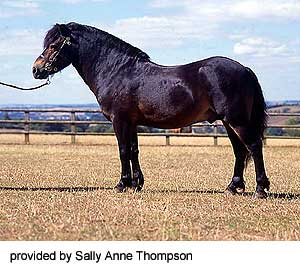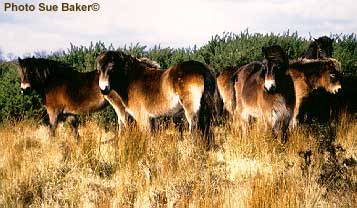

Exmoor Pony


Introduction: If you have any comments or suggestions, please click here.
Names: Exmoor, Exmoor Pony.
Origin: This
wild pony comes from the moors of Devon and Somerset.
Several
herds still live half-wild on Exmoor in southwest England. An English
breed, believed to be an indigenous animal descended from the wild horse of
Britain of prehistoric times. (While I am a creationist, I do believe in a
few basic horse types from which modern horses and ponies descend; the Exmoor
probably really is related to the original of its type.)
Like the Dartmoor pony, the Exmoor lives on the high, bleak,
sparsely inhabited moors of southwest England, especially in the county of
Somerset. Living under inhospitable conditions of climate and limited food
supply, the surviving Exmoor ponies have developed great hardiness and stamina.
Breeding: The oldest
breed in Britain, the Exmoor is not far removed from the Wild Horse. It is
believed to be descended from the original Celtic pony of western Europe.
Breeding area and studs--England. Bred in semi-wild
herds on Exmoor, and in a number of private studs. Stallions are very
carefully selected. (Exmoor Pony Society.) The indigenous,
half-wild English pony. In the distant past, along with the Oriental, one
of the founders of the Thoroughbred;
but crossed with the Thoroughbred
has produced some useful half-bred hunters.
Description: Slightly larger than the Dartmoor and preserved pure-bred in their natural habitat. The breed has remained very pure and is thought to have changed little since primitive times. Centuries ago they looked much as they do now. One source says they resemble the Welsh pony (probably meaning the Welsh Mountain), with strong signs of an ancient mingling with desert stock.
Action: Stride is reaching, without the showy elevation of the Welsh. Brisk action in all three gaits; smooth, flat trot; great galloping and jumping ability, vast amount of stamina for so small a pony.
Body: Short neck; well made, even somewhat compact, short shoulders; good withers; strong back with well-developed loins. Quarters rather oblique.
Color: Bay or brown with light, mealy-colored muzzles, eyelids and underparts. It has been said that the colors include brown, bay, black, gray, and chestnut; purebreds are never spotted. I am inclined to think this latter statement can refer to the domesticated Exmoor, while the wild ones are always the former. Usually brown, bay or dun with light shading on inside of thigh; mealy muzzle and "toad" eyes. Chestnuts and odd colours not allowed. No white markings.
Hair: Rough, springy coat. Characteristic wiry winter coat. Ample mane and tail, the former falling on both sides of the neck.
Head: Clean-cut, expressive head with short, pointed ears.
Legs: Exemplary forelegs with long forearms, short cannons and clean, well-defined tendons and joints. Occasionally cow-hocked.
Size: Small, about 12 hands. Up to 12.3 hands. Height not exceeding 12.3 hands for stallions and geldings; 12.2 hands for mares. 45-51 inches.
Temperament: Hardy and strong willed. Having fended for themselves for generations, Exmoors can be inherently nervous, but experienced handling turns them into excellent riding ponies.
Features: Rugged and spirited. Hardy, frugal, half-wild pony. surefooted, fast, intelligent. Very good jumper (when taught) and children's pony. Excellent breeder of quality children's ponies when crossed with the Thoroughbred.
Uses: Good riding ponies for children. Like their close relative, the Dartmoor, they are daring little jumpers and when crossed with full-size horses produce good hunters. On coming in from the wild, however, they are quite rough and need firm training.
Accomplishments:
Curiosities:
Profiles:
Conclusion: